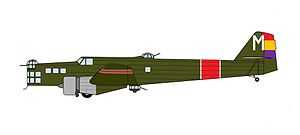Bloch MB.210
| Bloch MB.210 | |
|---|---|
 | |
| Bloch MB.210 of the Spanish Republican Air Force | |
| Role | Bomber |
| Manufacturer | Various, including: Les Mureaux Potez-CAMS Breguet Hanriot Renault |
| First flight | 23 November 1934 |
| Introduction | November 1936 |
| Retired | around 1945 |
| Status | retired |
| Primary user | French Air Force |
| Number built | < 300 |
| Developed from | Bloch MB.200 |
The MB.210 and MB.211 were the successors of the French Bloch MB.200 bomber built by Societé des Avions Marcel Bloch in the 1930s and differed primarily in being low wing monoplanes rather than high wing monoplanes.
Development
The MB.210 derived from the MB.200 and differs in particular by having its cantilever wing set at the bottom of the fuselage, and in having a retractable undercarriage.
Developed as a private venture, the prototype MB.210 accomplished its first flight on 23 November 1934, powered by two 596 kW (800 hp) Gnome-Rhône 14Kdrs / Gnome-Rhône 14Kgrs air-cooled radial engines and having a fixed undercarriage.[1] This was followed by a second prototype, the MB.211 Verdun, powered by 641 kW (860 hp) Hispano-Suiza 12Y V-12 liquid-cooled inlines and fitted with a retractable undercarriage, this flying on 29 August 1935.[2] Initial flight testing of this version was somewhat disappointing, so no further examples were built. Further progress with the MB.210, however, convinced the Armée de l'Air to order series production, the first example of which flew on 12 December 1936.[3]
The satisfaction did not last very long, however, since it was underpowered and the engines of production aircraft were inclined to overheating. The type was grounded until its engines could be replaced by the more powerful and reliable Gnome-Rhône 14N, these engines first being tested in summer 1937 and had to be replaced.[4] Altogether, 257 units were manufactured amongst companies as diverse as Les Mureaux over Potez-CAMS, Breguet, Hanriot, and Renault.
Operational history
In September 1939, the Bloch MB.210 equipped 12 bomber units of the Armée de l'Air. At the time of Nazi Germany's attack on France in spring 1940, these squadrons were in the middle of a restructuring aimed at removing outdated aircraft from the front line. Up to the armistice on 25 June of the same year, the MB.210 was used still for nighttime bomb employments and shifted then to North Africa.
Variants
- MB.210.01
- First prototype, powered by 2x 596 kW (800 hp) Gnome-Rhône 14Kdrs / Gnome-Rhône 14Kgrs air-cooled radial engines.
- MB.210Bn.4
- Initial production version, powereed by 2x Gnome-Rhône 14N-10 / Gnome-Rhône 14N-11 radial engines.
- MB.210Bn.5
- Hanriot-built variant with extra crew member.
- MB.210H
- Floatplane version powered by 2x Gnome-Rhône 14Kirs engines
- MB.211.01
- Prototype equipped with two 641 kW (860 hp) Hispano-Suiza 12Y inline engines.
- MB.212
- project[5]
- MB.218
- project[5]
Operators
 Bulgaria
Bulgaria- Bulgarian Air Force - Received six aircraft from Germany.[5]
 France
France
.svg.png) Germany
Germany- Luftwaffe - (Used briefly for training in 1942 after the German occupation of France)
 Romania
Romania- Royal Romanian Air Force - Received 10 from an order of 24.[5]
.svg.png) Spain
Spain- Spanish Republican Air Force received at least three[6] aircraft.[7]
Specifications (MB.210Bn.5)
Data from War Planes of the Second World War: Volume Seven [8]
General characteristics
- Crew: Five
- Length: 18.83 m (61 ft 9 in)
- Wingspan: 22.82 m (74 ft 10 in)
- Height: 6.70 m (21 ft 11¾ in)
- Wing area: 62.5 m² (673 ft²)
- Empty weight: 6,413 kg (14,109 lb)
- Loaded weight: 9,720 kg (21,385 lb)
- Max. takeoff weight: 10,221 kg (22,487 lb)
- Powerplant: 2 × Gnome-Rhône 14N-10 / Gnome-Rhône 14N-11 14-cylinder air-cooled radial engine, 709 kW (950 hp) each
Performance
- Maximum speed: 322 km/h (174 kn, 200 mph) at 3,500 m (11,480 ft)
- Cruise speed: 240 km/h (130 kn, 149 mph) (econ cruise) at 3,500 m (11,480 ft)
- Range: 1,700 km (918 nmi, 1,056 mi)
- Service ceiling: 9,900 m (32,480 ft)
- Wing loading: 156 kg/m² (31.8 lb/ft²)
- Power/mass: 0.15 kW/kg (0.089 hp/lb)
- Climb to 4,000 m (13,120 ft): 12 min
Armament
- Guns: 3 × 7.5 mm (.295 in) MAC 1934 machine guns (one in nose, dorsal and vental turrets)
- Bombs: 1,600 kg (3,520 lb) of bombs
See also
- Related development
- Related lists
- List of Interwar military aircraft
- List of aircraft of World War II
- List of aircraft of the Armée de l'Air, World War II
- List of aircraft of the Spanish Republican Air Force
- List of bomber aircraft
References
- Notes
- ↑ Green 1967, p.124.
- ↑ Green 1967, p. 125.
- ↑ Green 1967, p.126.
- ↑ Green 1967, p.127.
- ↑ 5.0 5.1 5.2 5.3 "Bloch MB 210–211." dassault-aviation.com. Retrieved: 2 November 2011.
- ↑ BLOCH 200/210
- ↑ MB 210-211. Dassault Aviation. Retrieved 17 August 2008.
- ↑ Green 1967, p. 128.
- Bibliography
- Green, William. War Planes of the Second World War: Bombers and Reconnaissance Aircraft, Volume Seven. London: Macdonald, 1967.
External links
| Wikimedia Commons has media related to Bloch aircraft. |
- aviafrance(French)
- MB 210-211: Dassault
| ||||||||||||||||||||||
| ||||||||||||||||||||||